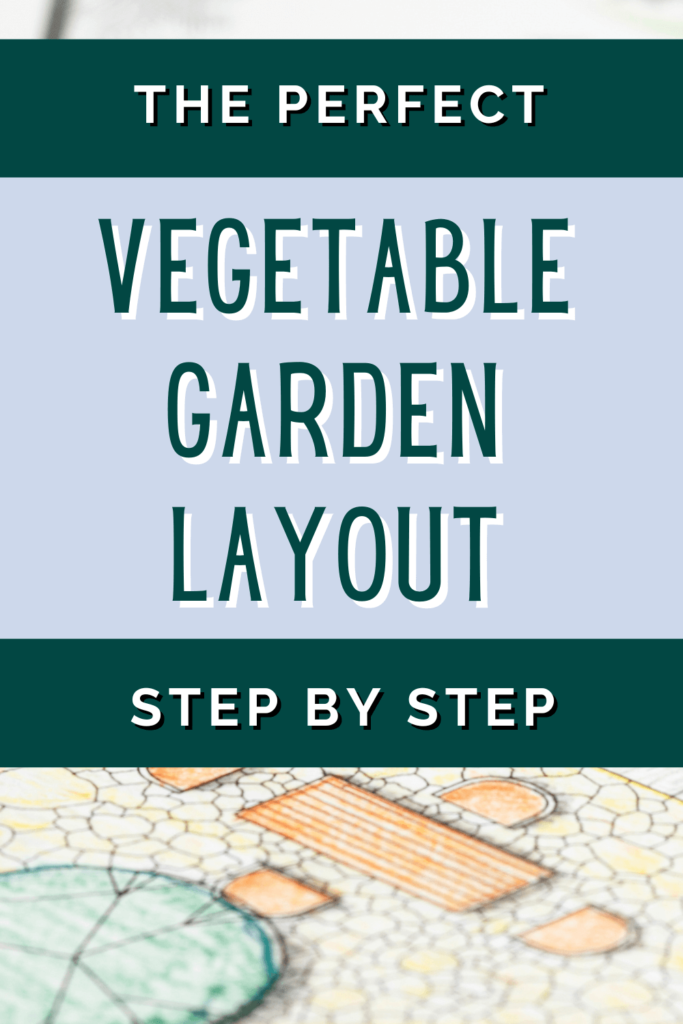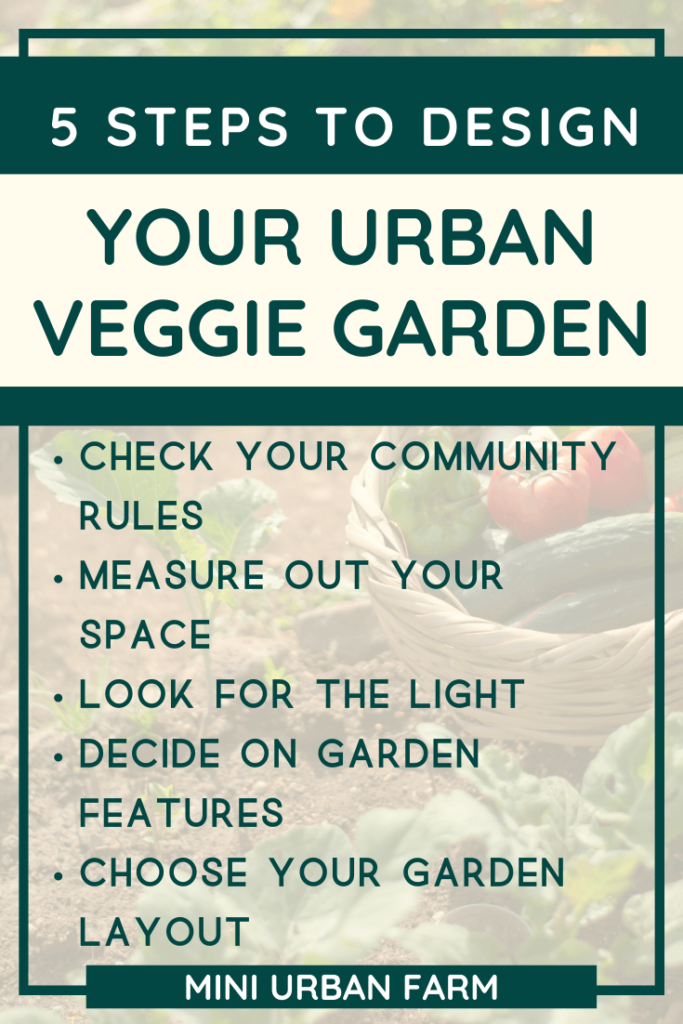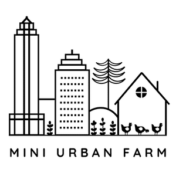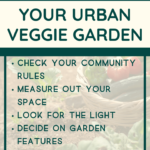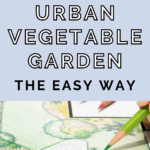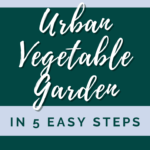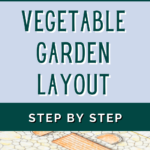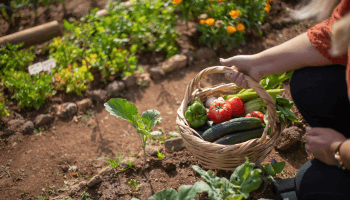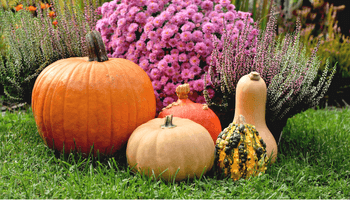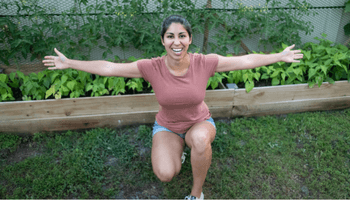How to design an urban vegetable garden is something a lot of urban gardeners struggle with, myself included. When we first installed a vegetable garden in our suburban backyard we were starting from scratch. So we wanted to make a complete list of everything we needed to include, and things to consider first. Our current garden is 30 feet long by 2 feet wide, which gives us 60 square feet of gardening space total – not a lot to work with. So making the most of our vegetable garden layout was essential!
How to Design an Urban Vegetable Garden:
- Check your community rules
- Measure out your space
- Look for the light
- Decide on garden features
- Choose your garden layout
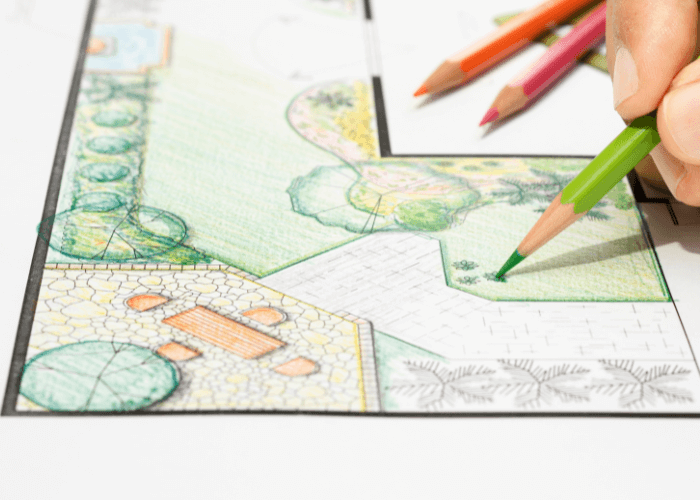
Disclosure: This post may contain affiliate links. If you purchase a product through one of our affiliate links we make a small commission from the sale at no extra cost to our readers.
How to Design an Urban Vegetable Garden
In a small garden it’s easy to use up the space. But what we’re really going for here is to use the space wisely.
That way you get more harvests in less space – and by doing less work.
Because the last thing you want to do is extra work!
So how to design an urban vegetable garden comes down to a few things. Observing your space, working with your space, and tweaking as needed.
1. Check Your Community Rules
The first thing you need to consider is any sort of rules from your home owners association, city ordinances, county rules, etc.
I live in a gated community and there are tons of rules about what you can plant in the ground. So it’s important to know what those are in order to work around them!
We have a fence here and in our HOA, we’re not allowed to put anything that shows above the fence. Which is pretty common for HOAs.
The way we’ve gotten around that is by simply making sure our trellis height is just below the fence. And trimming anything that gets too tall.
The same thing is true for planting inground. We are not allowed to have fruit-bearing plants in the ground.
But, by using raised garden beds, we have no issues.
Some other common rules include:
- Planting fruit trees
- Things protruding beyond the fence height
- Planting certain types of crops
- Planting crops that would be classified as weeds
- Installing garden beds
And if you want to start a garden, these rules can seem like a huge obstacle. But there are ways around them!
And it starts with knowing your rules and regulations wherever you live.
Because the last thing you want is to get fined or have to rip up your garden after the fact!
2. Measure Out Your Space
Step number two is to measure out your space. Because, of course, you need to know how much room you have to play with.
Now, you can build a garden in almost any size space. But if you want to grow food, I recommend at least a few garden beds.
This usually amounts to at least 50 square feet.
At this point, you’ll also want to start creating an outline of your space.
Draw out the current space, any fences, trees, and structures in that space.
This will come in handy later on when we’re looking at where to plant our crops.
3. Look for the light
You already know that plants need light to survive. But have you ever kept track of how much sunlight your space gets?
If you haven’t, now it the time to start!
To do this, just jot down the time of day when your garden first gets sunlight.
Usually this will be first thing in the morning. But it can be later as well, just depending on where your structures are.
For example, my old garden used to get sunlight starting around 10 am. And would have light until about 7 pm.
But my current garden gets light at about 7 am until about 3 pm.
The hours of sunlight are important to keep track of because you want to know they types of vegetables you can grow in that space.
Most veggies need full or partial sun in a space.
So if the spot you chose receives little sun throughout the day, you might want to reconsider the location of your garden.
Psst…want to fast track your garden? Get access to my FREE gardening resource library and start maximizing your garden today!
4. Decide on Garden features
Before you actually start building raised beds and adding in soil, you’ll want to consider any garden features you want to include.
This can be trellises, in ground or raised beds, a greenhouse, or even a garden bench.
But whatever you decide it’s important to plan out space for each of these ahead of time.
In my garden I have raised beds with a trellis, a mini greenhouse, a seed starting setup, a patio set with tables and chairs, and a drip irrigation system.
All of these things work together to create a productive, yet calm, backyard garden that I enjoy spending time in.
Now you might want to include more features in your backyard garden. But keep in mind that you can always modify the space later on – and you should!
As you see what works (or what’s a waste of space) you can tweak your garden until it works for you.
There are a few things however, that I would recommend you have in your garden:
- a watering system – drip lines work best, but even if you just have a spigot and watering can nearby your job will be easier
- seed starting setup – it’s essential to have a place to start your seeds (and store your tools!)
- trellises – growing vertically is one of the easiest ways to max out your garden space
5. Choose Your Garden Layout
The layout for your vegetable garden has the potential to make or break the success of your garden.
You’ll want to maximize the sunlight your garden gets, but also keep it easily accessible.
My previous garden was a U-shaped garden – which I loved because it gave me more space to walk down the middle and pick vegetables on either side.
U shaped gardens work really well for small spaces.
Here are some other good urban vegetable garden layouts:
- Market garden rows – these are uniform and easily accessible from both sides
- Patterned designs – think beautiful aerial shots where garden beds are symmetrical and pleasing to the eye
- Forest gardens – while this might be less orderly, you can pack lots of food in a small space using permaculture principles
In my opinion, the perfect vegetable garden layout will make the best use of your existing space, capitalize on sunlight, be close to a water source, and include some design elements that make you want to spend more time there!
small space gardening techniques
In small spaces you’ll want to make use of every last inch you have to grow food.
But there are a few techniques that are easy to master and that will make your urban vegetable garden layout super successful.
Square Foot Gardening
I absolutely love square foot gardening! And it’s definitely one of the best ways to maximize garden space.
If you’ve never heard of square foot gardening, basically it’s a method of breaking your space up into a grid of square foot boxes.
Now, you can opt to literally create a grid, or just have an imaginary grid that you use to plant your crops.
But the main selling point with this technique is that you can plant a certain number of each crop into a single square foot.
For example, tomatoes require 1 square foot of gardening space.
But you can fit as many as 9 bean plants into only 1 square foot.
Just look up the spacing requirements for each crop you want to grow, and plant out that many per square foot.
It doesn’t get much easier than that!
Intercropping
Now, this technique is a little bit more advanced. But it’s a great one for maximizing garden space.
Take our tomato example, for instance. Tomatoes require about 1 square foot of space to grow.
But if we have an indeterminate variety (a vining tomato) that ground space will be virtually untouched since the plant grows mainly on a trellis.
So in that space right beneath the plant, we can grow some ush beans, some herbs, or even some carrots!
This makes use of all the space, instead of letting it go to waste.
Just make sure to check that the things you’re intercropping with actually grow well together.
The last thing you want is to find out that your plants are not good companions and are actually preventing each other from growing successfully!
Succession Planting
The third small space gardening method I’m going to share requires a bit of preparation.
Enter succession planting.
In this technique we are actually calculating days to maturity for each of our crops, and when that crop is ready to harvest, we have something ready to take it’s place.
This prevents the space from sitting empty and you get more food in the same space!
What plants are best for urban gardening?
Urban gardening is unique in the sense that most urban and suburban spaces are on the smaller side. Therefore, it’s important to plant crops that maximize food production in a small space.
That’s why trellising vegetables are a great fit for urban gardens since they allow you to grow vertically and save ground space!
Other great plants for urban gardening include cut and come again varieties since they produce so much in a short time span. And salad greens since they take so little time and effort to grow!
Of course, you can grow pretty much anything in an urban gardening space. And like they say, when there’s a will, there’s a way!
How much Does a Vegetable Garden Cost?
An average sized suburban garden will cost at least a few hundred dollars. Which includes preparing the ground space, installing raised beds, and filling the beds with soil.
This cost will increase if you add trellises or other garden features to your design, but can vary by garden and the area you garden in.
Of course, there are hundreds of ways to garden on a budget. Including making your own compost and saving your own seeds.
But generally, you will need to spend some money on the start up costs for your garden.
Keep in mind, however, that the return on investment for a garden is pretty high. Just think about all that produce you won’t have to buy from the store!
And for my exact cost breakdown of my urban vegetable garden, check out this post.
Raised Beds vs In Ground Gardens
If you’re debating between raised bed gardening versus in ground garden beds, there are a few things to keep in mind.
One, depending on where you live you may not be allowed to have an in ground garden. Always check the community rules before you get started!
Or maybe the soil is so compacted in your area that it would take a lot of work to fit. In that case, maybe a raised bed garden would be best.
But generally speaking, if I have the option to create an in ground garden, that would be ideal.
Firstly, you don’t need to buy the soil for in ground beds – unless you’re replacing the soil for some reason.
And secondly, in ground beds retain water so much better than raised beds. Which means less watering for you and happier plants.
Now, if you have any medical issues that would prevent you from leaning down to garden, a raised bed might be a good choice.
Just keep in mind that you’ll need to amend the soil more frequently and water more often!
Gardening in ground and in raised beds can be successful, so chose the one that works for you and use the tips above to design the perfect garden!
Use these tips on how to design an urban vegetable garden and you’ll be well on your way to a successful harvest in no time!
And for more gardening resources, get access to our free gardening resource library! It will help you fast track your garden and it only takes 5 seconds!
PIN How to Design an Urban Vegetable Garden
